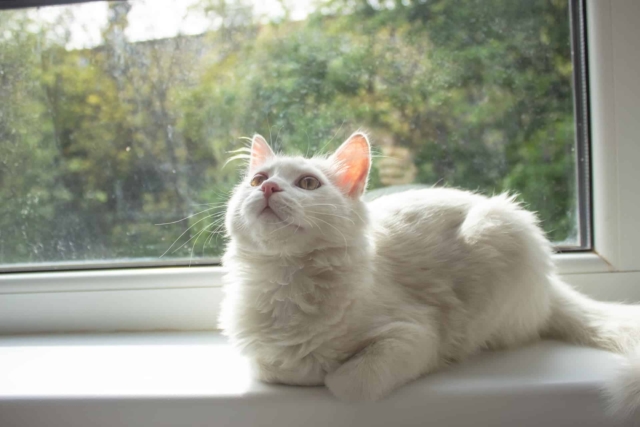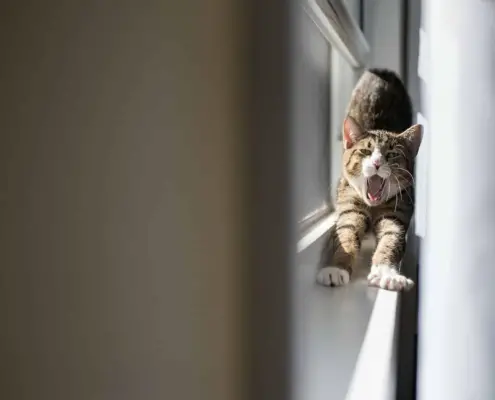
Understanding your cat’s interests is crucial for building a strong bond with your feline companion. Cats are complex creatures with unique personalities, and just like humans, they have specific likes and dislikes. By taking the time to understand what your cat enjoys, you can provide them with a stimulating and fulfilling environment that promotes their overall well-being.
One of the main reasons why understanding your cat’s interests is important is because it helps prevent boredom. Cats are natural hunters and explorers, and when they’re not mentally and physically engaged, they can become bored and frustrated. This can lead to destructive behavior, such as scratching furniture or excessive meowing. By catering to your cat’s interests, you can keep them entertained and happy, reducing the likelihood of behavioral issues.
Signs that your cat has specific interests
Cats often display clear signs when they have specific interests. Some common signs include:
- Preference for certain toys: Pay attention to which toys your cat gravitates towards. For example, if they always choose the feather wand over the mouse toy, it’s a clue that they enjoy interactive play and hunting games.
- Exploratory behavior: If your cat constantly explores new areas of your home or loves to climb to high places, it indicates a curiosity for their environment. Providing vertical spaces, such as cat trees or shelves, can satisfy this interest.
- Reaction to different sounds: Notice how your cat reacts to various sounds. Some cats may be intrigued by the sound of chirping birds or the rustling of leaves, indicating an interest in nature. Others may be more responsive to the sound of a crinkling paper or a jingling bell.
By observing these signs, you can gain valuable insights into your cat’s interests and tailor their environment accordingly.
The benefits of unleashing your cat’s inner explorer
Unleashing your cat’s inner explorer comes with a host of benefits. Firstly, it promotes physical activity, which is crucial for maintaining a healthy weight and preventing obesity-related issues. By providing opportunities for your cat to climb, jump, and play, you’re helping them burn calories and stay fit.
Secondly, engaging your cat’s natural instincts through interactive play and exploration provides mental stimulation. This mental exercise is essential for preventing cognitive decline and keeping your cat’s brain sharp. It can also help alleviate stress and anxiety, as it allows your cat to engage in natural behaviors that bring them joy.
Additionally, allowing your cat to explore their environment and follow their interests enhances their overall quality of life. Cats are curious creatures, and by providing them with opportunities to investigate, hunt, and play, you’re fulfilling their natural instincts and promoting their emotional well-being.
Creating an enriching environment for your cat
Creating an enriching environment for your cat is key to unlocking their inner explorer. Here are some tips to consider:
- Provide vertical spaces: Cats love to climb and perch in high places. Invest in a cat tree or install shelves at different heights to give your cat the opportunity to explore and observe their surroundings from above.
- Offer a variety of toys: Provide a range of toys that cater to your cat’s interests. This can include interactive puzzle toys, feather wands, and balls that encourage chasing and pouncing. Rotate the toys regularly to keep them fresh and engaging.
- Designate a window perch: Place a comfortable bed or cushion near a window so your cat can enjoy the sights and sounds of the outdoors. This allows them to engage with nature while remaining safe indoors.
- Create hiding spots: Cats love to hide and seek. Provide cozy hiding spots, such as covered beds or cardboard boxes, where your cat can retreat to when they need some alone time or want to engage in a game of hide-and-seek.
By incorporating these elements into your cat’s environment, you’re creating a stimulating and enriching space that encourages exploration and satisfies their natural instincts.
Toys and activities that cater to your cat’s interests
Understanding your cat’s interests can help you select toys and activities that they will truly enjoy. Here are some ideas based on different cat personalities:
- Hunter cats: If your cat has a strong prey drive, toys that mimic natural prey, such as feather wands or laser pointers, will captivate their attention. These toys allow your cat to engage in hunting behaviors and provide mental and physical stimulation.
- Climber cats: For cats that love to climb, invest in a sturdy cat tree or install shelves at different heights. This allows them to fulfill their desire for vertical exploration and gives them a sense of security.
- Intellectual cats: Some cats enjoy a mental challenge. Puzzle toys, treat-dispensing balls, or interactive feeders are great options for cats that like to use their problem-solving skills.
- Social cats: If your cat is social and enjoys human interaction, engage in playtime using interactive toys that require your involvement. Feather wands, fishing rod toys, or toys attached to strings can provide hours of entertainment for both you and your cat.
Remember to always supervise your cat during playtime and choose toys that are safe and appropriate for their age and size.
Incorporating interactive playtime into your cat’s routine
Interactive playtime is a vital part of keeping your cat stimulated and satisfied. It’s important to incorporate regular play sessions into your cat’s daily routine. Here are some tips for making interactive playtime enjoyable for both you and your cat:
- Set aside dedicated playtime: Schedule at least two play sessions of 10-15 minutes each day. This ensures that your cat receives regular mental and physical exercise.
- Use toys that mimic prey: Toys that resemble natural prey, such as feather wands or toy mice, are great for interactive play. Move the toy in ways that mimic the movements of prey, encouraging your cat to engage in hunting behaviors.
- Vary the play style: Cats have different play preferences. Some enjoy stalking and pouncing, while others prefer chasing or wrestling. Observe your cat’s preferred play style and adapt your movements to match their interests.
- Reward your cat: After a successful play session, reward your cat with treats or praise. This positive reinforcement helps strengthen the bond between you and your cat and encourages them to look forward to playtime.
Remember to always end play sessions on a positive note, allowing your cat to wind down and relax after an engaging session.
Understanding your cat’s prey drive and providing appropriate outlets
Cats have an innate prey drive, which is a natural instinct to hunt and capture prey. Understanding your cat’s prey drive is crucial for providing appropriate outlets for this behavior. Here are some ways to satisfy your cat’s prey drive:
- Interactive toys: Toys that mimic prey, such as wand toys with feathers or toys attached to strings, allow your cat to engage in hunting behaviors. Move the toy in ways that simulate the movement of prey, encouraging your cat to stalk, chase, and pounce.
- Hide and seek: Hide treats or toys around the house for your cat to find. This taps into their natural hunting instincts and provides mental stimulation.
- Outdoor enclosures: If you have a safe and secure outdoor space, consider investing in a cat enclosure. This allows your cat to experience the sights, sounds, and smells of the outdoors while remaining protected from potential dangers.
- Indoor hunting games: Interactive puzzle toys or treat-dispensing balls can simulate the challenge of hunting and provide mental stimulation for your cat. These toys require your cat to use their problem-solving skills to access the treats or kibble inside.
By providing appropriate outlets for your cat’s prey drive, you’re allowing them to engage in natural behaviors in a safe and stimulating manner.
Exploring different types of interactive feeders for mental stimulation
Interactive feeders are a fantastic way to provide mental stimulation for your cat during mealtime. These feeders require your cat to engage in problem-solving behaviors to access their food, promoting mental exercise and preventing boredom. Here are some types of interactive feeders to consider:
- Puzzle feeders: These feeders contain hidden compartments or obstacles that your cat needs to navigate to access their food. This encourages your cat to think and strategize, making mealtime more engaging.
- Slow feeders: Slow feeders are designed to slow down your cat’s eating pace. They typically have maze-like patterns or raised obstacles that require your cat to eat around or between. This not only provides mental stimulation but also prevents digestive issues associated with fast eating.
- Treat-dispensing balls: Treat-dispensing balls are hollow toys that dispense treats when your cat interacts with them. Fill the ball with your cat’s favorite treats or kibble, and watch as they roll it around to access the rewards.
- Snuffle mats: Snuffle mats are mats with long fabric strips that hide treats or dry food. Your cat has to use their nose and paws to search for the hidden food, mimicking the behavior of foraging in the wild.
Introduce interactive feeders gradually to allow your cat to adjust and learn how to use them. This not only provides mental stimulation but also makes mealtime a more enjoyable and rewarding experience for your feline friend.
Introducing your cat to the great outdoors safely
While it’s important to provide your cat with opportunities to explore the great outdoors, it’s equally important to keep them safe. Here are some ways to introduce your cat to the outdoors safely:
- Harness and leash training: Train your cat to wear a harness and walk on a leash. This allows them to experience the outdoors under your supervision while preventing them from wandering off or getting into dangerous situations.
- Enclosed outdoor spaces: If you have a backyard, consider creating an enclosed outdoor space specifically for your cat. Use cat-proof fencing or install a catio to provide a safe and secure area for your cat to enjoy fresh air and sunshine.
- Supervised outdoor time: If you have a safe and secure outdoor space, you can allow your cat to explore under your watchful eye. Stay close and ensure there are no potential hazards or escape routes.
- Window perches and bird feeders: Install a window perch near a window with a bird feeder outside. This allows your cat to safely observe and engage with nature without direct access to the outdoors.
By following these safety measures, you can provide your cat with the joys of the outdoors while ensuring their well-being and minimizing potential risks.
Nurturing your cat’s interests for a happy and fulfilled feline
Understanding your cat’s interests is key to nurturing their overall well-being. By identifying their preferences and providing a stimulating environment, you can unleash their inner explorer and promote a happy and fulfilled feline companion. From creating an enriching environment to incorporating interactive playtime and understanding their prey drive, there are numerous ways to cater to your cat’s interests and enhance their quality of life. Remember to experiment with different toys, activities, and feeders to find what truly engages your cat. By investing time and effort into understanding your cat’s interests, you’re building a stronger bond and ensuring a lifetime of happiness for your beloved feline friend.
Spend quality time with your cat today! Engage in interactive play and observe their interests to create a stimulating and fulfilling environment. Your furry friend will thank you for it!
If you enjoyed my article, I would appreciate you sharing it with your network.

Sima Ndlebe
Sima writes for CatBuzz. He is interested in Cats, Health and Fitness, and Entrepreneurship.
Published: 15 November 2023



